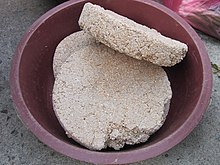Nuruk
Nuruk ( Hangul: 누룩 ) minangka pamula fermentasi tradisional Korea. [1] [2] [3] [4] Iki digunakake kanggo nggawe macem-macem jinis omben-omben Korea kayata takju, cheongju, lan soju . [5] Iki minangka bahan penting ing Shindari lan dicampur karo beras. [6] Secara historis, digunakake ing macem-macem provinsi Korea, kalebu Pulau Jeju .

Gandum, pari (kalorone jinis ketan lan ora lemut), lan gandum digunakake kanggo nggawe nuruk, minangka gabah utuh utawa arupa grit utawa glepung. [7] [8] Nuruk gandum minangka jinis sing paling umum. Gandum garing dibasahi, dibentuk dadi jajan gedhe, lan digantung nganti difermentasi nganti 2‒4 minggu ing ruangan ondol . [9] Kue mateng ing suhu sing tepat nganti cetakan bentuk.
Referensi
besut- ↑ "Fermented Cereals a Global Perspective. Chapter 3." Fermented Cereals a Global Perspective. Chapter 3. Web. 04 Mar. 2016.
- ↑ Lee, Cherl-Ho (1999). "Cereal Fermentations in Countries of the Asia-Pacific Region". Ing Haard, Norman F.; Odunfa, S.A.; Lee, Cherl-Ho; Quintero-Ramírez, R.; Lorence-Quiñones, Argelia; Wacher-Radarte, Carmen (èd.). Fermented cereals : a global perspective. FAO Agricultural Services Bulletin. Rome: Food and Agriculture Organization. kc. 91. ISBN 92-5-104296-9. ISSN 1010-1365. Dibukak ing 19 June 2017.
- ↑ Shin, Dong-Hwa; Kim, Young-Myoung; Park, Wan-Soo; Kim, Jae-Ho (2016). "Ethnic Fermented Foods and Beverages of Korea". Ing Tamang, Jyoti Prakash (èd.). Ethnic Fermented Foods and Alcoholic Beverages of Asia. India: Springer. kc. 298. Dibukak ing 23 September 2017.
- ↑ McKay, Marianne; Buglass, Alan J.; Lee, Chang Gook (2011). "Fermented Beverages: Beers, Ciders, Wines and Related Drinks". Ing Buglass, Alan J. (èd.). Handbook of Alcoholic Beverages: Technical, Analytical and Nutritional Aspects. Chichester, UK: Wiley. kc. 214–216. ISBN 978-0-470-51202-9. Dibukak ing 23 September 2017.
- ↑ Yoo, Jong-Gil. Nuruk, a Traditional Korean Fermentation Starter, contains the Bioactive Compound 2,6-dimethoxy-1,4-benzoquinone (2,6-DMBQ). Online.
- ↑ Nowicki, Stephen. Holt McDougal Biology. Orlando, FL: Holt McDougal, 2012. Print.
- ↑ Lee, Cherl-Ho (1999). "Cereal Fermentations in Countries of the Asia-Pacific Region". Ing Haard, Norman F.; Odunfa, S.A.; Lee, Cherl-Ho; Quintero-Ramírez, R.; Lorence-Quiñones, Argelia; Wacher-Radarte, Carmen (èd.). Fermented cereals : a global perspective. FAO Agricultural Services Bulletin. Rome: Food and Agriculture Organization. kc. 91. ISBN 92-5-104296-9. ISSN 1010-1365. Dibukak ing 19 June 2017.
- ↑ Yokotsuka, T. (1985). "Fermented protein foods in the Orient, with emphasis on shoyu and miso in Japan". Ing Wood, Brian J. B. (èd.). Microbiology of Fermented Foods. Vol. 1. London: Elsevier Applied Science Publishers. kc. 197–247. ISBN 978-1-4613-7990-4.
- ↑ Shin, Dong-Hwa; Kim, Young-Myoung; Park, Wan-Soo; Kim, Jae-Ho (2016). "Ethnic Fermented Foods and Beverages of Korea". Ing Tamang, Jyoti Prakash (èd.). Ethnic Fermented Foods and Alcoholic Beverages of Asia. India: Springer. kc. 298. Dibukak ing 23 September 2017.